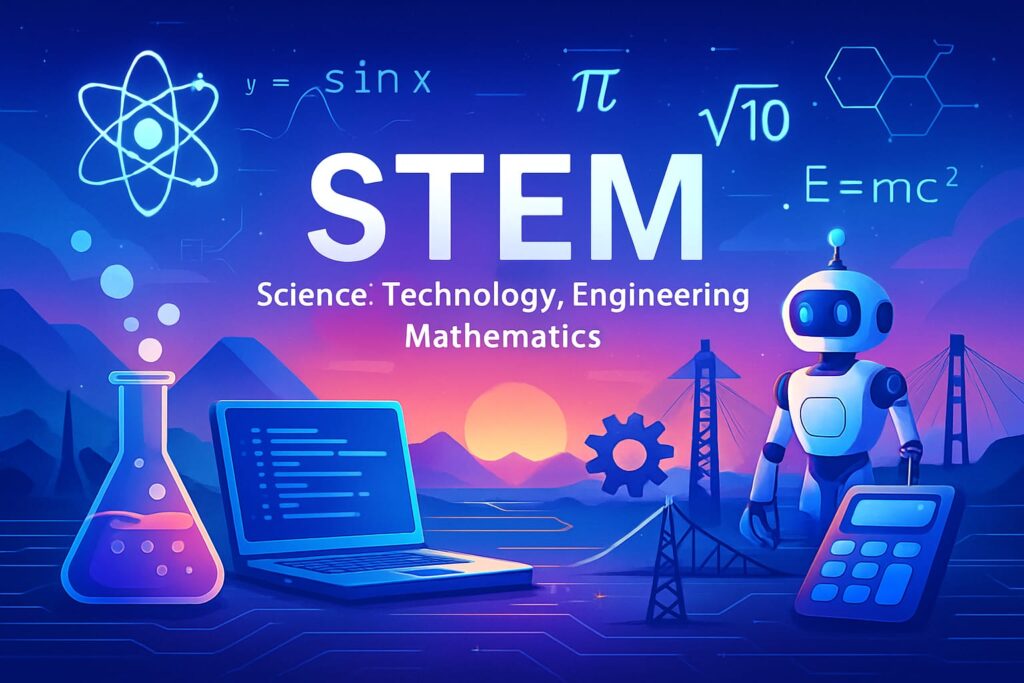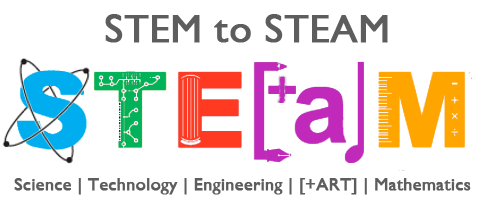
Welcome back to LearnWithJigasha.
I have been getting questions about What is STEM Education and why it is important. This blog will address all such questions and give clarity.
Who introduced the word STEM?
STEM education was first introduced in 2001 and has existed for decades. However, the education system and educational administrators now acknowledge its importance.
The word STEM, which is an abbreviation first introduced in the United States in the year 2001 by scientific administrators at the U.S. National Science Foundation (NSF). National Science Foundation (NSF), is an independent agency of the U.S. government that supports basic research and education in a wide range of sciences and mathematics and engineering. The NSF was established by the U.S. Congress in the National Science Foundation Act of 1950.
STEM stands for below as four disciplines –
- Science
- Technology
- Engineering
- Mathematics
In STEM education, the field and curriculum centred on education in the disciplines of science, technology, engineering, and mathematics. It is an interdisciplinary approach where the above disciplines of academics are integrated and incorporated with real-world applications.
STEM was previously referenced as SMET when representing the career fields in the above four fields and a curriculum that integrated knowledge and skills from that field. However; in 2001, American biologist Judith Ramaley, then assistant director of education and human resources at NSF, rearranged the words to form the STEM acronym. Since then, STEM-focused curriculum has been extended to many countries beyond the United States, with programs developed in places such as Australia, China, France, South Korea, Taiwan, and the United Kingdom.
What is STEM Education?
By now you must have understood that STEM is an abbreviation for science, technology, engineering, and mathematics.
However, STEM education is far more than just sticking to those subject titles together. It has brought a revolutionary change in learning and given a different perspective to the philosophy of education, which embraces teaching skills and subject study in a way that resembles real life. It gives a skill set that governs the way we think and perform. The key component of STEM is an integrated approach to learning different subjects together. Reconciliation of the scientific concepts makes it more helpful in practical application and gives a clear view that these concepts are not different.
Why STEM Education is important?
A major deficiency of traditional education is that each subject is considered separate and students keep on learning many subjects separately but when it comes to practical knowledge students often are unable to apply concepts learned, to the actual problems.
That is, most students are incapable of reconciling theoretical knowledge to practical problems which reduces their efficiency, comprehensibility, and implementation. It becomes a gap between learning a concept and its applications to real-world problems.
If this gap in learning is not addressed at the right time and effectively the education becomes meaningless and of no use. If this flaw is not considered in the early years of learning, it will worsen the problem even, or it may end up in children losing interest in studies.
Ultimately this loose end may result in many problems –
- Unemployment
- Weak productivity
- Inhibition of brain development
- School/college dropout
- Mental distress
Hence, it is important to introduce a STEM-based curriculum and policies of education in schools and colleges. STEM education is a practical base knowledge method of teaching subjects and ensures no loose ends in understanding any concept.
It helps children to apply what they learn to the right place and promotes long-term memory retention of any concept.
What is STEAM?
After a few years when STEM became a buzzword in the education domain, a new word came into appearance. It was called STEAM. In STEAM, the letter “A” refers to Arts. The introduction of this new field helped educators to get more benefits from hands-on education and promoting creativity, logical thinking, and imagination. This not only made learning fun but also encouraged the curiosity at the core of education.

STEAM has become so popular that many pre-primary and primary schools are incorporating teaching methodology which is more in alignment with STEAM education. The inclusion of arts makes learning more fun and engaging for students. In research done by the National Assembly of State Arts Agencies, it is found that students scored better on standardized tests when they were more active in arts as compared to those who were less active in arts.
STEAM is not attempted to take away from STEM or its subject area, but instead an approach to enhance productivity and creativity. It is in focus that children have to develop both sides of the brain equally and this makes them so efficient that they can solve almost any problem that comes into the way.
STEAM is not a new concept. Many personalities from the last like Leonardo Da Vinci have proven the importance of combining science and art to make discoveries through his paintings.
What is the difference between STEM and STEAM?
The main difference between STEM and STEAM lies in the methods of learning and their approach to scientific concepts. STEM is the hardcore study of fields like science, technology, engineering, and mathematics with practical application to living problems or to develop a new concept.
While in STEAM with the inclusion of art learning all the fields of STEM become more creative and fun-orientated. Hence, STEAM makes use of both hard and soft skills to analyze and solve any problem in the real world. STEAM promotes “out of the box” thinking by improving the visualization and imagination power of the brain.

When to introduce STEM or STEAM learning?
STEM / STEAM or both should be introduced in the early stage of learning. In the early stage, that is the initial age of 2 to 6 years of learning kids are like a pitcher of raw clay which you can put in the shape according to your own. The learning pace at this age is maximum and cannot be the same ever in the rest of life.
Hence introducing STEM / STEAM properly will help in building a positive attitude towards learning, in a child.
It is very well known through research that kids already have enough understanding of the outside world before their schooling begins as they are keen to learn new things and have their attitude to explore things. Our task is to strengthen their innate power which they already have and we start this at the earliest level rather than waiting for later years of growth.
Benefits of including STEM education in schools
Until now we have understood STEM & STEAM with their importance, let us go through the benefits of using STEM / STEAM-based learning.
A blend of core study of subjects integrated into STEM / STEAM with imagination and creativity fosters new ideas and inventiveness.
Even then to get a clear sight of It let’s discuss its benefits of in detail:
- Foundation of our technological society – Businesses and jobs which are the base of the economy of any country are generally dependent upon science, technology, engineering and mathematics which are complex and multi-later discipline systems. These are taught in STEM in an integrated form. STEM education ensures that these four streams which are the pillars of the progress of any country are taught to the masses.
- Rigid Cognitive base – STEM is introduced in school because schools are the productive ground for future technicians, scientists, engineers and mathematicians. Moreover, STEM education nurtures young minds from the beginning and provides a rigid cognitive or intellectual base for future scientists and many others.
- Interesting learning practices – Children are more likely to remember the concepts which are introduced practically and creatively. STEM involves hands-on learning of these concepts and in an integrated form rather than teaching them separately. This also becomes a fun way of learning and keeps alive the essence of curiosity to learn new things. Hence, the core of STEM is to impart practical learning in a fun way. This helps kids and students to retain more information and understand the concepts better.
- Excellent Analytic Proficiency – In STEM education education policies and curriculum develop critical thinking attitudes in children, which remarkably helps them to become scientist-minded individuals. The focus aspects of the scientific mind are curiosity, doubt, an open mind and modesty. This mindset is not only helpful in work but is advantageous to cultivate the way of approaching the real world in daily life.
- Integrated learning – In STEM education the four different streams of education namely science, technology, engineering and mathematics are integrated rather than taught separately, which gives understanding to pupils that all these fields are interrelated, not different and this promotes critical thinking.
Conclusion
Nowadays the standard of education has become very high and more and more competitive. Whether it is a job hunt or real-world problems, to stand out as an individual, everyone needs to do something different. One must possess better objective analysis and evaluation of the problem to make a firm decision. STEM plays an important role in empowering this type of critical thinking skill within a child. Hence STEM should be introduced in pre-primary and primary schools. Once the strong foundation is laid in the early stage of development, the higher stages of learning are easy to achieve with similar strength, and the overall learning will be well-equipped for cutting-edge competition and overall development of the brain and promising future.
Hope this blog has helped you to understand the importance of including STEM and STEAM in the Education Domain.
Keep reading our blog post to learn more about educational topics and continue with your learning journey.
Do share your ideas in the comment box for more informative and educational blogs.


1 thought on “STEM Education”